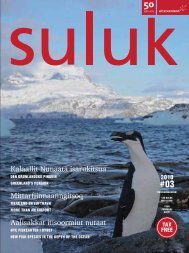Klik her for at se PDF'en - Air Greenland
Klik her for at se PDF'en - Air Greenland
Klik her for at se PDF'en - Air Greenland
Create successful ePaper yourself
Turn your PDF publications into a flip-book with our unique Google optimized e-Paper software.
CHARLOTTE SIGSGAARD<br />
■<br />
Dram<strong>at</strong>ic trans<strong>for</strong>m<strong>at</strong>ion<br />
Clim<strong>at</strong>e changes will result in a dram<strong>at</strong>ic trans<strong>for</strong>m<strong>at</strong>ion of n<strong>at</strong>ure in<br />
Northeast <strong>Greenland</strong>. In a worst ca<strong>se</strong> scenario, this could affect the global<br />
clim<strong>at</strong>e through the so-called »global feed-back« mechanisms<br />
By Hans Meltofte, Morten Rasch and Martin Stendel<br />
■ Zackenbergimi sulianut tamanut qitiusoq tassaavoq<br />
silasiorfik isumaminik ingerl<strong>at</strong>itaq, ukioq kaajallallugu<br />
silap pissusaanut tunngasunik arlalissuarnik<br />
nalunaarsuisartoq.<br />
The impact of global warming is felt<br />
most strongly in the Arctic regions.<br />
New clim<strong>at</strong>e models indic<strong>at</strong>e th<strong>at</strong> the<br />
temper<strong>at</strong>ure in the Arctic could increa<strong>se</strong><br />
by up to eight degrees over the next<br />
100 years. The results of 10 years of<br />
re<strong>se</strong>arch <strong>at</strong> Zackenberg in Northeast<br />
<strong>Greenland</strong> show th<strong>at</strong> t<strong>her</strong>e will be farreaching<br />
con<strong>se</strong>quences <strong>for</strong> the Arctic<br />
eco-systems and th<strong>at</strong> the<strong>se</strong> con<strong>se</strong>quences<br />
could have a dram<strong>at</strong>ic effect<br />
on the clim<strong>at</strong>e in the rest of the world.<br />
T<strong>her</strong>e are two major factors involved.<br />
First and <strong>for</strong>emost, enormous quantities<br />
of cold <strong>se</strong>a w<strong>at</strong>er sink in w<strong>at</strong>ers<br />
off Northeast <strong>Greenland</strong>. This sinking,<br />
which is called »the cold heart of the<br />
oceans«, drives ocean currents all over<br />
the globe and is t<strong>her</strong>e<strong>for</strong>e responsible<br />
<strong>for</strong> much of the transport<strong>at</strong>ion of<br />
warmth from south to north. Think of<br />
the Gulf Stream which ensures the mild<br />
clim<strong>at</strong>e in North West Europe. But the<br />
<strong>Air</strong> <strong>Greenland</strong> inflight magazine 55<br />
■ Centeret <strong>for</strong> alt arbejdet i Zackenberg er en autom<strong>at</strong>isk<br />
vejrst<strong>at</strong>ion, som året rundt registrerer en<br />
lang række klim<strong>at</strong>iske parametre.<br />
sinking is highly dependent on the temper<strong>at</strong>ure<br />
off Northeast <strong>Greenland</strong> and<br />
on the <strong>for</strong>m<strong>at</strong>ion of <strong>se</strong>a ice. If the temper<strong>at</strong>ure<br />
increa<strong>se</strong>s and less ice is <strong>for</strong>med,<br />
the pump’s action will slow down<br />
and the currents will become weaker.<br />
The question is, how much weaker?<br />
The ot<strong>her</strong> gre<strong>at</strong> unknown factor is<br />
wh<strong>at</strong> will happen with the enormous<br />
amount of pe<strong>at</strong> th<strong>at</strong> is accumul<strong>at</strong>ed in<br />
the Arctic. It has been calcul<strong>at</strong>ed th<strong>at</strong><br />
20 per cent of the world’s biologically<br />
bound carbon is contained in the<strong>se</strong><br />
pe<strong>at</strong> layers. When the temper<strong>at</strong>ure<br />
increa<strong>se</strong>s, the pe<strong>at</strong> will start to decay<br />
releasing the bound carbon into the<br />
<strong>at</strong>mosp<strong>her</strong>e in the <strong>for</strong>m of carbon<br />
di oxide and methane. This will exacerb<strong>at</strong>e<br />
the greenhou<strong>se</strong> effect, which will<br />
result in even more global warming<br />
and so on and so on. Just as with most<br />
ot<strong>her</strong> ecological proces<strong>se</strong>s in the Arctic,<br />
melting snow is a decisive factor <strong>for</strong><br />
■ The centre <strong>for</strong> all the work <strong>at</strong> Zackenberg is an<br />
autom<strong>at</strong>ic we<strong>at</strong><strong>her</strong> st<strong>at</strong>ion th<strong>at</strong> registers a long<br />
<strong>se</strong>ries of clim<strong>at</strong>ic parameters all year round.<br />
the carbon balance, as the start of the<br />
growing <strong>se</strong>ason to a high degree determines<br />
how much carbon dioxide and<br />
methane is exchanged between the<br />
tundra and the <strong>at</strong>mosp<strong>her</strong>e during the<br />
summer.<br />
The time when the snow melts is a key<br />
factor in the understanding of not only<br />
the effects on plant and animal life,<br />
but also the effects of future clim<strong>at</strong>e<br />
chang es in the Arctic. The melting<br />
snow has t<strong>her</strong>e<strong>for</strong>e been the subject of<br />
targeted re<strong>se</strong>arch and we will sub<strong>se</strong>quently<br />
take a clo<strong>se</strong>r look <strong>at</strong> the results.<br />
Several clim<strong>at</strong>e zones<br />
The Arctic is divided into a high Arctic<br />
and a low Arctic zone. The low Arctic<br />
zone is often fertile, with bushes and<br />
ot<strong>her</strong> knee-high plants, whilst the<br />
high Arctic zone only has ankle-high<br />
plants. Here, the mean temper<strong>at</strong>ure <strong>for</strong><br />
the warmest month does not usually



